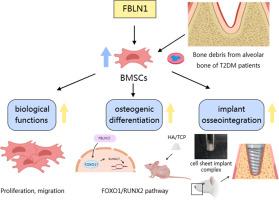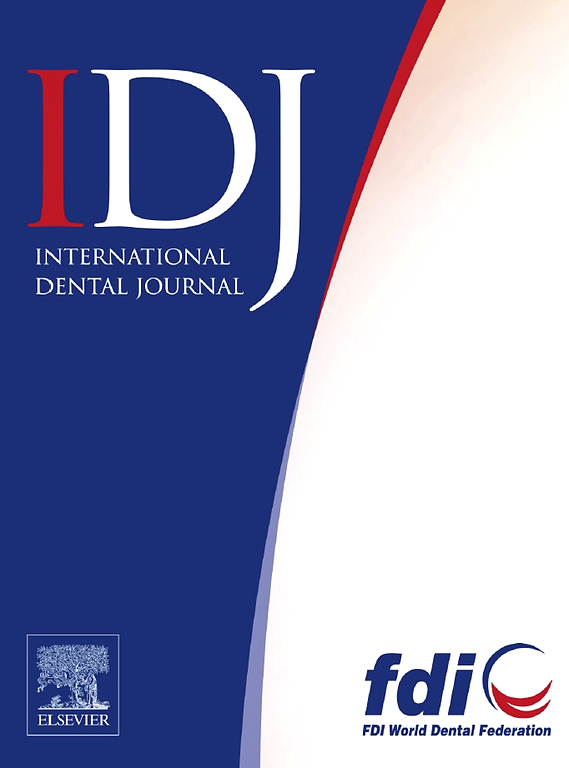Fibulin1 as a Novel Target for Promoting the Biological Function of Bone Marrow Mesenchymal Stem Cells and Implant Osseointegration in Diabetic Patients
IF 3.7
3区 医学
Q1 DENTISTRY, ORAL SURGERY & MEDICINE
引用次数: 0
Abstract
Background and aims
Type 2 diabetes mellitus (T2DM) is recognized as a significant risk factor affecting implant osseointegration. Our previous proteomic study revealed that Fibulin1 (FBLN1) was significantly downregulated in the alveolar bone marrow mesenchymal stem cells (BMSCs) of T2DM patients with implant failure. This study aimed to verify the effects of FBLN1 on the biological function of BMSCs and implant osseointegration in T2DM patients to identify novel intervention targets for the future development of clinical treatments.
Materials and methods
In in vitro experiments, FBLN1 was overexpressed in BMSCs from diabetic patients via lentiviral transduction. The effects of FBLN1 on the biological functions of BMSCs were assessed via a CCK8 assay, a wound healing assay, a Transwell assay, alkaline phosphatase staining, alizarin red staining, and subcutaneous osteogenesis analysis using nude mice. The molecular mechanism by which FBLN1 acts on BMSCs was verified via RT-qPCR and western blotting. In in vivo experiments, the effect of FBLN1 on implant osseointegration in diabetic GK rats through cell sheet–implant complexes was verified by microcomputed tomography and toluidine blue staining.
Results
FBLN1 was expressed in BMSCs at an early stage of the osteogenic process. CCK8, wound healing, and Transwell assays indicated that the overexpression of FBLN1 increased the proliferation and migration of BMSCs. Alkaline phosphatase staining, alizarin red staining and subcutaneous osteogenesis analysis revealed that the overexpression of FBLN1 enhanced the osteogenic differentiation of BMSCs, and RT-qPCR and western blotting revealed that FBLN1 affected this process through the FOXO1/RUNX2 signalling pathway. Microcomputed tomography and toluidine blue staining revealed that after the implantation of cell sheet–implant complexes in rats, overexpressing FBLN1 in BMSCs could restore the level of implant osseointegration in GK rats to a level similar to that in Wistar rats.
Conclusions
FBLN1 enhances the proliferation and migration of BMSCs from T2DM patients and promotes osteogenic function through the FOXO1/RUNX2 signalling pathway. Moreover, FBLN1 promotes implant osseointegration in diabetic GK rats, suggesting that FBLN1 is a novel target protein for increasing the success rate of dental implant surgery in T2DM patients.

Fibulin1作为促进糖尿病患者骨髓间充质干细胞生物学功能和种植体骨整合的新靶点
背景与目的2型糖尿病(T2DM)被认为是影响种植体骨整合的重要危险因素。我们之前的蛋白质组学研究显示,T2DM患者植入失败的肺泡骨髓间充质干细胞(BMSCs)中Fibulin1 (FBLN1)显著下调。本研究旨在验证FBLN1对T2DM患者骨髓间充质干细胞生物学功能和种植体骨整合的影响,为今后临床治疗的发展确定新的干预靶点。材料与方法在体外实验中,FBLN1通过慢病毒转导在糖尿病人骨髓间充质干细胞中过表达。通过CCK8实验、创面愈合实验、Transwell实验、碱性磷酸酶染色、茜素红染色和裸鼠皮下成骨分析,评估FBLN1对骨髓间充质干细胞生物学功能的影响。通过RT-qPCR和western blotting验证FBLN1作用于骨髓间充质干细胞的分子机制。在体内实验中,通过微计算机断层扫描和甲苯胺蓝染色验证了FBLN1通过细胞片-种植体复合物对糖尿病GK大鼠种植体骨整合的影响。结果fbln1在成骨早期在骨髓间充质干细胞中表达。CCK8、伤口愈合和Transwell实验表明,FBLN1的过表达增加了骨髓间充质干细胞的增殖和迁移。碱性磷酸酶染色、茜素红染色和皮下成骨分析显示,FBLN1过表达增强了骨髓间充质干细胞的成骨分化,RT-qPCR和western blotting显示FBLN1通过FOXO1/RUNX2信号通路影响这一过程。微计算机断层扫描和甲苯胺蓝染色显示,大鼠植入细胞片-种植体复合物后,BMSCs中过表达FBLN1可使GK大鼠种植体骨整合水平恢复到与Wistar大鼠相似的水平。结论sfbln1通过FOXO1/RUNX2信号通路促进T2DM患者骨髓间充质干细胞的增殖和迁移,促进成骨功能。此外,FBLN1促进糖尿病GK大鼠种植体骨整合,提示FBLN1是提高T2DM患者种植体手术成功率的新型靶蛋白。
本文章由计算机程序翻译,如有差异,请以英文原文为准。
求助全文
约1分钟内获得全文
求助全文
来源期刊

International dental journal
医学-牙科与口腔外科
CiteScore
4.80
自引率
6.10%
发文量
159
审稿时长
63 days
期刊介绍:
The International Dental Journal features peer-reviewed, scientific articles relevant to international oral health issues, as well as practical, informative articles aimed at clinicians.
 求助内容:
求助内容: 应助结果提醒方式:
应助结果提醒方式:


